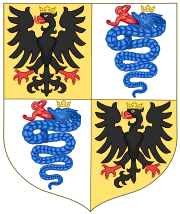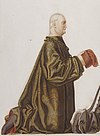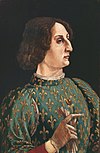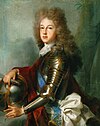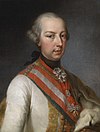|
List of dukes of Milan
Milan was ruled by dukes from the 13th century to 1814, after which it was incorporated into the Kingdom of Lombardy–Venetia by the Congress of Vienna. List of dukes of MilanHouse of ViscontiIn 1395, Gian Galeazzo Visconti was titled Duke of Milan by King Wenceslaus,[1] who sold the title under the payment of circa 100,000 florins.[2] Since that moment, all the following rulers of Milan were styled as dukes.
House of Sforza (1st rule)After the death of Filippo Maria in 1447, the main line of Visconti went extinct. Benefited by political chaos, a cabal of wealthy citizens, academics and clerics declared the Duchy dissolved and proclaimed the oligarchical Golden Ambrosian Republic.[3] The republic was never recognized and the neighboring states of Venice and Savoy tried to expand their fiefdoms in Lombardy, as well as France. Taking advantage of the state's weakness and the resurgent Guelph-Ghibelline conflict, the commander-in-chief of the Milanese forces, Francesco I Sforza, defected from Milan to Venice in 1448,[4] and two years later, after several side switches and cunning strategies, Sforza entered the city during Annunciation. He was then declared the new Duke of Milan by the City Council,[5] using as a claim his marriage with Bianca Maria Visconti, illegitimate daughter of Filippo Maria.
House of Valois (1st rule)In 1494, Ludovico Sforza usurped the throne of Milan, after probably poisoning his nephew Gian Galeazzo. After the threats of the Venetians, Ludovico solicited French king Charles VIII to descend into Italy,[6] starting the First Italian War. After Ludovico's betrayal and alliance with the League of Venice in 1495, the French were defeated in the Battle of Fornovo and were unable to expand in Italy. Charles VIII's top general and cousin, Louis II, Duke of Orléans (future Louis XII), was humiliated and due to his personal hate toward Ludovico Sforza,[7] started to claim the Duchy of Milan for himself, quoting his paternal descendance from Valentina Visconti and Gian Galeazzo's last will. After Louis XII's ascension to the French Throne in 1499, he started the Second Italian War to conquer Milan and Naples. With French armies near Pavia, Ludovico and his loyalists left Milan on 17 September 1499 to flee toward Germany.[8] This left Louis XII as the only Duke of Milan, entering the city on 6 October 1499.[9]
House of Sforza (2nd rule)Ludovico Sforza was captured on February 1500,[10] dying in prison in 1508. His son Massimiliano became the Sforza claimant to the Milanese Throne, which he finally re-gained in January 1513, six months after the Swiss army's entrance in Milan.
House of Valois (2nd rule)After their defeat in the Battle of Marignano in 1515, the Swiss retired from Milan and Massimiliano was imprisoned by the returning French troops. He waived his rights to Milan for the sum of 30,000 ducats and continued to live in France.[11]
House of Sforza (3rd rule)By November 1521, the French situation had deteriorated considerably. Emperor Charles V, Henry VIII of England, and Pope Leo X signed an alliance against Francis on 28 November.[12] Odet de Foix, Viscount of Lautrec, the French governor of Milan, was tasked with resisting the Imperial and Papal forces; he was outmatched by Prospero Colonna, however, and by late November had been forced out of Milan and had retreated to a ring of towns around the Adda River.[13] For the third time and last time, the Sforza were restored to power.
House of HabsburgIn 1535, after the death of the heirless Francesco II Sforza, Emperor Charles V annexed the Duchy as a vacant imperial state in order to avoid other claims by the French or the collateral branches of Sforza. House of Habsburg-SpainIn 1540, the Duchy was secretly given as a gift to Charles V's son Philip, Prince of Asturias. This was made official at the abdication of Charles V in 1555. In 1556, Philip became Philip II of Spain and Milan entered in personal union with the Spanish Crown.
House of Bourbon-AnjouIn September 1700, Charles became ill; by 28 September he was no longer able to eat and Portocarrero persuaded him to alter his Will in favour of Louis XIV's grandson, Philip of Anjou.[14] When Charles died on 1 November 1700, the throne was offered to Philip, who was proclaimed King of Spain on 16 November 1700. This was accepted by Britain and the Dutch Republic, among others. Disputes over division of territories and commercial rights led to the War of the Spanish Succession in 1701.[15]
House of Habsburg-Austria (then Habsburg-Lorraine)After the Treaty of Rastatt of 1714, Emperor Charles VI officially gained the Duchy of Milan, a possession considered vital to the security of Austria's southern border.[16] Since that moment, Milan was a permanent possession of the Austrian branch of the Habsburg dynasty.
See also
References
Bibliography
|
||||||||||||||||||||||||||||||||||||||||||||||||||||||||||||||||||||||||||||||||||||||||||||||||||||||||||||||||||||||||||||||||||||||||||||||||||||||||||||||||||||||||||||||||||||||||||||||||||||||
Portal di Ensiklopedia Dunia

